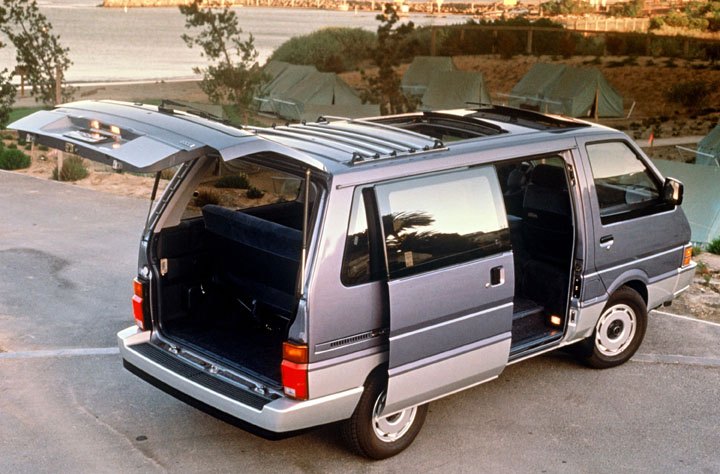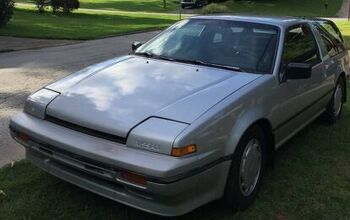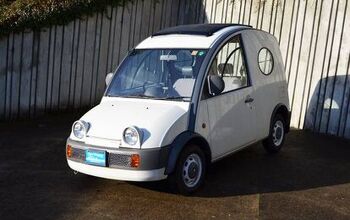Rare Rides: A 1988 Nissan Van, Not Yet on Fire

Today’s Rare Ride represents Nissan’s first attempt at a family van for the North American market. But Nissan would prefer you forget the Van entirely, given how things went after its introduction.
1989 Nissan Van.
The vehicle known as Van in the North American market was sold as Vanette elsewhere. Introduced in 1979 as the Nissan Datsun Vannette or on occasion Datsun C20, the first-gen van’s production ran from late 1978 to 1988. Concurrently, Nissan introduced a second Vanette in 1985 which remained in Japanese production through 1994 and extended its life in the Philippines through 2001, and Malaysia through 2010. Good grief!
The mid-engine rear-drive layout was how Japan made its vans at that time and was never entirely popular in the North American market which preferred its engines at the front. In 1986 Nissan brought the Vanette to North America, called it Van, and pitched it against the Toyota Van and the Mitsubishi Van/Wagon. All three imports vied for customers from the minivan of choice, the Chrysler minivan.
Engines for Vanette around the globe ranged from a microscopic 1.2-liter inline-four through a 2.0-liter gasoline or diesel engine. But that wouldn’t do for the wide-open American roadways and its drivers’ desire for more powah. Americans also expected air conditioning (sapping even more power), in contrast to Vanette buyers elsewhere. So Nissan made a small edit for its Van: the 2.4-liter Z24i engine from the Nissan Hardbody and early Pathfinders. That inline-four was sandwiched under the front seats, in an engine bay that was a bit too small for 2.4 liters.
The Van was marketed as a cheaper alternative to the Chrysler minivan, but most buyers shopped elsewhere anyway. The Van was imported only through the 1989 model year before it was killed by slow sales. And recalls, multiple recalls! That large engine and small space combo didn’t work out so well, and the Van would often overheat and potentially burst into flame. The problem was made worse by sales concentrated in three hot places: Texas, Florida, and California.
By 1994, Nissan had issued four recalls to try and fix the overheating, to little success. There was also a class action lawsuit pending at the time, and Nissan threw up their hands. In an unprecedented buyback recall action, Van owners were offered at least Kelly Blue Book value to bring their overheating minivan to their local dealer. This offer was acceptable to most owners, who turned in their Van so it could be crushed. Before the buyback was completed in 1994, more than 135 Van fires were documented. None resulted in death or injury, to the chagrin of US lawyers. The class action was settled too, and its members were offered discounts on a new Nissan, like the Quest!
Today’s Van was owned by some dedicated soul who risked life and limb for boxy burgundy in high-spec GXE form. The two-tone Van has accumulated 127,000 miles since 1988 and looks in superb condition. It’s yours for $8,900 and is likely the only option for the dedicated Nissan Van Enthusiast out there.
[Images: Nissan]

Interested in lots of cars and their various historical contexts. Started writing articles for TTAC in late 2016, when my first posts were QOTDs. From there I started a few new series like Rare Rides, Buy/Drive/Burn, Abandoned History, and most recently Rare Rides Icons. Operating from a home base in Cincinnati, Ohio, a relative auto journalist dead zone. Many of my articles are prompted by something I'll see on social media that sparks my interest and causes me to research. Finding articles and information from the early days of the internet and beyond that covers the little details lost to time: trim packages, color and wheel choices, interior fabrics. Beyond those, I'm fascinated by automotive industry experiments, both failures and successes. Lately I've taken an interest in AI, and generating "what if" type images for car models long dead. Reincarnating a modern Toyota Paseo, Lincoln Mark IX, or Isuzu Trooper through a text prompt is fun. Fun to post them on Twitter too, and watch people overreact. To that end, the social media I use most is Twitter, @CoreyLewis86. I also contribute pieces for Forbes Wheels and Forbes Home.
More by Corey Lewis
Latest Car Reviews
Read moreLatest Product Reviews
Read moreRecent Comments
- Master Baiter I told my wife that rather than buying my 13YO son a car when he turns 16, we'd be better off just having him take Lyft everywhere he needs to go. She laughed off the idea, but between the cost of insurance and an extra vehicle, I'd wager that Lyft would be a cheaper option, and safer for the kid as well.
- Master Baiter Toyota and Honda have sufficient brand equity and manufacturing expertise that they could switch to producing EVs if and when they determine it's necessary based on market realities. If you know how to build cars, then designing one around an EV drive train is trivial for a company the size of Toyota or Honda. By waiting it out, these companies can take advantage of supply chains being developed around batteries and electric motors, while avoiding short term losses like Ford is experiencing. Regarding hybrids, personally I don't do enough city driving to warrant the expense and complexity of a system essentially designed to recover braking energy.
- Urlik You missed the point. The Feds haven’t changed child labor laws so it is still illegal under Federal law. No state has changed their law so that it goes against a Federal child labor hazardous order like working in a slaughter house either.
- Plaincraig 1975 Mercury Cougar with the 460 four barrel. My dad bought it new and removed all the pollution control stuff and did a lot of upgrades to the engine (450hp). I got to use it from 1986 to 1991 when I got my Eclipse GSX. The payments and insurance for a 3000GT were going to be too much. No tickets no accidents so far in my many years and miles.My sister learned on a 76 LTD with the 350 two barrel then a Ford Escort but she has tickets (speeding but she has contacts so they get dismissed or fine and no points) and accidents (none her fault)
- Namesakeone If I were the parent of a teenage daughter, I would want her in an H1 Hummer. It would be big enough to protect her in a crash, too big for her to afford the fuel (and thus keep her home), big enough to intimidate her in a parallel-parking situation (and thus keep her home), and the transmission tunnel would prevent backseat sex.If I were the parent of a teenage son, I would want him to have, for his first wheeled transportation...a ride-on lawnmower. For obvious reasons.





































Comments
Join the conversation
I had a coworker who had one of these. She was pissed about them selling her an unsafe vehicle and pissed about them not offering her enough money to buy it back, but she ended up getting a used Nissan Sentra Station Wagon from the dealer who had sold her the Van.
One of the advantages the Chrysler front engine/front drive vans had over these was that you could easily walk between the two front seats or between the first and second rows. Now front-engine front drive (or AWD) is ubiquitous in small vans, but some brands (Toyota, Kia) are voluntarily squandering that advantage by fitting huge center consoles that look like the one in this Nissan. I don't get it. One thing I remember about the Nissan Van was the exposed steering column, like in a 1950s Ford.